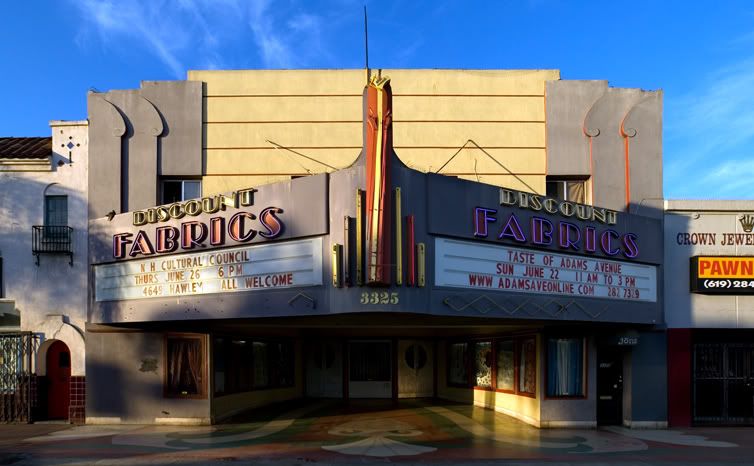Neighborhood Cinema

The Carteri, then Adams Avenue Theatre. (1924)
For my neighbor, Mrs. Kahan, this was the neighborhood movie theatre she enjoyed from 1947 when she first moved to Normal Heights.
“After the matinee you could catch a street car on Adams for a nickle and ride anywhere in town to find a place to eat.”

The house went black in 1962. The interior was adapted as retail space. But at least the exterior was kept mostly intact, minus the ticket booth which sat there in the middle. The terrazzo is in fairly good shape, although back in the day these received regular finish to maintain a high gloss. It is a bit dull now. And the display cases that once showed coming attraction posters are still intact. All too often display cases of converted movie theatres are boarded up or covered. Historic Photo.

I was in Westchester recently visiting my long time friend Kenny Garrett. We walked a few blocks from his house and he showed me what used to be his neighborhood theatre, the Loyola. That neon tower stood some 60 feet high. Note the illuminated display cases. It opened on October 3, 1946. It went dark in the 1980s. The above is a historic photo from the 1970s.

Although the shell of the Loyola remains there are no remaining movie theater elements inside. It is all office space. And what is left outside is a far cry from how it used to look. Someone was in love with shot-crete or stucco. Every inch was plastered with it. Marquee, display cases and the tower.

In the historic photo notice the detailed ornament adorning the plumage rising above the marquee. There’s a discussion in the THEATRE HISTORICAL SOCIETY OF AMERICA’s 1987 annual about the genre of architecture the Loyola belongs to. They refer to it as the “Skouras style,” named after two brothers–Skouras- who managed several cinema chains. Their designer was named Carl G. Moeller. He utilized new technology and materials, namely aluminum to achieve this highly ornate decor inside and out. The result was a style landing somewhere between Art Moderne and Streamlined. The grandiose sweeping and swirling was possible because aluminum was cheap–ornamental forms of aluminum were easy to craft and mass produce. So they went hog wild with flamboyant movie house design.

All that ornamental detail is covered up. All that neon is gone.
I probably don’t need to mention the Swan motif. But I will because the venue was always matched up with films of like theme. The Loyola first ran To Kill A Mockingbird. And the run of Alfred Hitchcock’s The Birds is something people still talk about. “There were several “dead†artificial birds placed along the marquee. Most interesting and clever was the box office where two or three of the birds had been cut in half and pasted to either side of the window, each ‘head’ stuck on the inside with the ‘tail’ on the outside. Tiny ‘cracks’ were painted on the glass. This gave the appearance that the ‘birds had crashed right through!” Mike H.

The terrazzo isn’t too shabby. However I noticed at one end a few spray-painted lines. The kind you see just before a jack hammer shows up.
The Loyola sat 1,234 people. It boasted an army of uniformed ushers and usherettes. There was lots of red velvet. Fancy bathrooms. Fancy snackbar. Stadium seating in back. This show had it all.